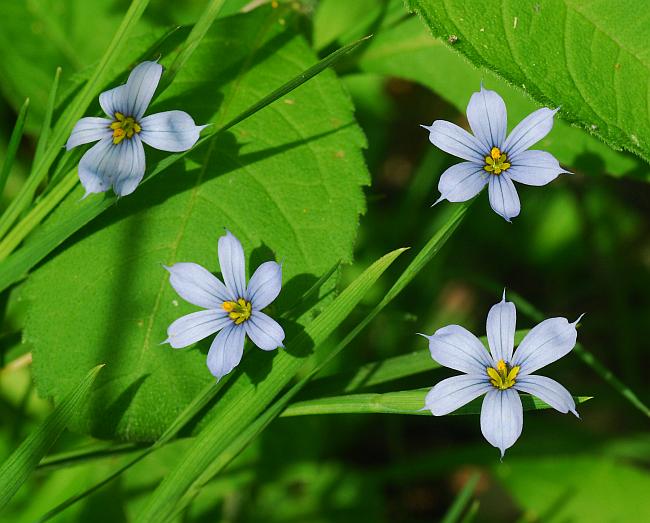Sisyrinchium angustifolium Mill.
Blue-Eyed Grass

Native
CC = 5
CW = 0
MOC = 59
© SRTurner
Sisyrinchium angustifolium Mill.Blue-Eyed Grass | |
 |
Native CC = 5 CW = 0 MOC = 59 |
© SRTurner |
|
Family - Iridaceae Habit - Perennial forb with fibrous roots, lacking rhizomes. Stem - Ascending to erect, to 50 cm, 2-6 mm wide, usually broadly winged, appearing branched, not glaucous.
Leaves - Basal or nearly so, few, linear, the leaf blades flat, 2-6 mm wide, not glaucous, sometimes darkening upon drying. Inflorescences - Inflorescences 1-4 per aerial stem, from often broadly winged stalks 4-15 cm long arising from the axils of leaflike bracts. Spathelike bracts of each inflorescence 1.3-4.0 cm long, green, sometimes purplish tinged, mostly with the outer bract 1.5-2.0 times as long as the inner bract at flowering time.
Flowers - Flowers with stalks 8-18 mm long. Perianth 5-12 mm long, spreading, pale blue to purple, usually with a well-developed yellow "eye" at the base, the sepals and petals similar and fused at the bases, oblanceolate with the tips abruptly narrowed into an attenuate tip, sometimes with the attenuation protruding from an apical notch. Styles with 3 linear lobes. Stamens with the filaments fused to the tips or nearly so.
Fruits - Capsules 2-6 mm long, globose. Seeds black, globose.
Flowering - May - July Habitat - Forests, streambanks, prairies, fields, roadsides, railroad tracks. Origin - Native to the U.S. Lookalikes - Other species of Sisyrinchium. Other info. - This species is common across most of Missouri but apparently absent from the central portion of the state and perhaps the northwestern and far southeastern corners. It is also abundant throughout the eastern half of the continental U.S. At a quick glance it looks the same as the even more common S. campestre, but differs in that the inflorescences are borne on secondary stalks, which arise from the axil of a bracted node on the stem. There are usually two of these stalked inflorescences (and up to four) per stem. In addition, the stems are broadly winged and up to 6 mm wide, unlike the narrower stems of the much less common S. atlanticum. Differentiation from this latter species can be difficult in some cases. Photographs taken at Weldon Spring Conservation Area, St. Charles County, MO, 5-9-2012, and at Route 66 State Park, St. Louis County, MO, 5-10-2015 (SRTurner). |